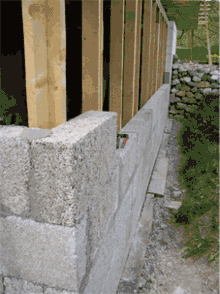Hempcrete

Hempcrete or Hemplime is bio-composite material, a mixture of hemp hurds (shives) and lime (possibly including natural hydraulic lime,[1] sand, pozzolans) used as a material for construction and insulation.[2] It is marketed under names like Hempcrete, Canobiote, Canosmose, and Isochanvre.[3] Hempcrete is easier to work with than traditional lime mixes and acts as an insulator and moisture regulator. It lacks the brittleness of concrete and consequently does not need expansion joints.[3] The result is a lightweight insulating material ideal for most climates as it combines insulation and thermal mass.
Hempcrete has been used in France since the early 1990’s to construct non-weight bearing insulating infill walls, as hempcrete does not have the requisite strength for constructing foundation and is instead supported by the frame. France continues to be an avid user of hempcrete; it is growing in popularity annually[4].
Like other plant products, hemp absorbs CO2 from the atmosphere as it grows, retaining the carbon and releasing the oxygen. Theoretically 165 kg of carbon can be absorbed and locked up by 1 m3 of hempcrete wall during manufacture.[5]
The typical compressive strength is around 1 MPa,[6] around 1/20 that of residential grade concrete. It is a low density material and resistant to crack under movement thus making it highly suitable for use in earthquake-prone areas. Hempcrete walls must be used together with a frame of another material that supports the vertical load in building construction, as hempcrete's density is 15% that of traditional concrete.[7]
Limecrete, Ltd. (UK) reports a fire resistance rating of 1 hour per British/EU standards.[8]
In the United States, permits are needed for the use of hemp in building.[9]
See also
References
- ↑ Allin, Steve. Building with Hemp, Seed Press, 2005, ISBN 978-0-9551109-0-0. (p. 146, 1st Edition).
- ↑ "NNFCC Renewable Building Materials Factsheet: An Introduction". National Non-Food Crops Centre. February 21, 2008. Retrieved 2011-02-16.
- 1 2 Priesnitz, Rolf B. (March–April 2006). "Hemp For Houses". Natural Life Magazine.
- ↑ Rhydwen, Ranyl (2018-05-18). "Building with Hemp and Lime".
- ↑ "Tradical Hemcrete 2008 Information Pack". American Lime Technology. Retrieved 2010-05-15.
- ↑ "Tradical Hemcrete 2008 Information Pack". American Lime Technology. Retrieved 2009-08-25.
- ↑ Flahiff, Daniel (August 24, 2009). "Hemcrete®: Carbon Negative Hemp Walls". Inhabitat.
- ↑ Abbott, Tom (2014-04-26). "Hempcrete Factsheet". The Limecrete Company, Ltd.
- ↑ Popescu, Adam (2018). "There's No Place Like Home, Especially if It's Made of Hemp". The New York Times. Retrieved 4 May 2018.
External links
| Wikimedia Commons has media related to Hemp concrete. |
- Hemcrete application data from Limetechnology